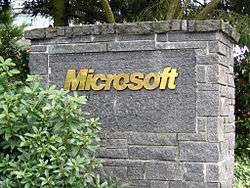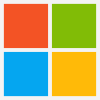Microsoft Redmond campus
 A sign at the campus entrance | |
| Built | 1986 |
|---|---|
| Location | Redmond, Washington |
| Coordinates | 47°38′31″N 122°07′38″W / 47.64194°N 122.12722°WCoordinates: 47°38′31″N 122°07′38″W / 47.64194°N 122.12722°W |
| Industry | Technology |
| Employees | 30,000–40,000 |
| Buildings | 80 |
| Area | 500 acres (200 ha)[1] |
| Address | One Microsoft Way, Redmond, Washington |
| Owner(s) | Microsoft |
The Microsoft campus is the informal name of Microsoft's corporate headquarters, located at One Microsoft Way in Redmond, Washington. Microsoft initially moved onto the grounds of the campus on February 26, 1986, weeks before the company went public on March 13. The headquarters has since experienced multiple expansions since its establishment.
It is estimated to encompass over 8 million square feet (740,000 m2) of office space and 30,000-40,000 employees.[2] Additional offices on the Eastside area of the Seattle metropolitan area are located in Bellevue and Issaquah.
History
Microsoft chose to move its headquarters from Bellevue to nearby Redmond in January 1985, selecting a 29-acre (12 ha) plot of land that would be developed by Wright Runstad & Company.[3] Construction began on August 9, and Microsoft moved into the $25 million facility on February 26, 1986, several weeks before the company's initial public offering.[4][5] The move generated some concerns about increased traffic congestion on the unfinished State Route 520 freeway between Bellevue and Redmond;[6] a new freeway interchange at Northeast 40th Street would later be built in 2000 to service the campus, after lobbying and partial funding from Microsoft.[7][8] The initial campus was on a 30-acre (12 ha) lot with six buildings, and was able to accommodate 800 employees but eventually grew to 1,400 by 1988.[9] The campus was originally leased to Microsoft from the Teachers Insurance and Annuity Association, a pension fund manager, until it was bought back in 1992.[10]
The first major expansion of the campus came in 1992, bringing the total amount of office space to 1.7 million square feet (160,000 m2) on 260 acres (110 ha) of land. Microsoft also announced its intention to contain most its future growth within Redmond, while retaining some offices in Downtown Bellevue and Factoria.[11]
In January 2006, Microsoft announced the purchase of Safeco's Redmond campus after the company had begun consolidating its offices at the Safeco Tower in Seattle's University District a year earlier.[12] In February 2006, Microsoft announced that it intended to expand its Redmond campus by 1,100,000 square feet (100,000 m2) at a cost of $1 billion and said that this would create space for between 7,000 and 15,000 new employees over the following three years.[13]
In 2009, a shopping mall called "The Commons" was completed on the campus, bringing 1.4 million square feet (130,000 m2) of retail space, as well as restaurants, a soccer field and pub to the West Campus.[14]
Future expansion
The Seattle Times reported in early September 2015 that Microsoft had hired architecture firm Skidmore, Owings & Merrill to begin a multibillion-dollar redesign of the Redmond campus, using an additional 1.4 million square feet (130,000 m2) allowed by an agreement with the City of Redmond.[1] The city of Redmond had also approved a rezone in February 2015 to raise the height limit for buildings on the campus from 6 stories to 10.[15]
Transportation
The campus is located on both sides of the State Route 520 freeway, which connects it to the cities of Bellevue and Seattle as well as the Redmond city center. Microsoft paid part of the cost for an overpass over the freeway at NE 36th Street to relieve congestion on other cross-streets in the area.[16]
The campus is served by buses to Seattle and some Eastside cities at the Overlake Transit Center, operated by Sound Transit and King County Metro. The RapidRide B Line also runs through the campus, connecting to downtown Bellevue and Redmond.[17] The transit center opened in 2002 and will be the eastern terminus of the East Link light rail extension, scheduled to open in 2023.[18][19] Microsoft partnered with Sound Transit and the City of Redmond to fund a pedestrian bridge connecting the light rail station to both sides of its campus to open in 2020, providing $33.3 million of the cost.[20][21]
For employees, Microsoft also operates a commuter bus service called "The Connector" that provides non-stop service to neighborhoods in Seattle, the Eastside, and Snohomish County from the Redmond campus.[22] The shuttles, which began operating in 2007, were targeted in early 2014 as a symbol of gentrification in similar fashion to the Google bus protests in San Francisco, California that same year.[23][24][25]
The company also runs a shuttle bus service, named the "Shuttle Connect", between buildings on the campus.[26]
References
- 1 2 Yu, Hui-yong; Bass, Dina (September 4, 2015). "Microsoft considers multibillion-dollar overhaul to Redmond campus". The Seattle Times. Retrieved September 8, 2015.
- ↑ "Facts About Microsoft". Microsoft. Retrieved July 21, 2015.
- ↑ "Microsoft Corp. to move its headquarters to Redmond". The Seattle Times. January 15, 1985. p. B2.
- ↑ Buck, Richard (March 9, 1986). "Computer Memory Explored Conference reveals just how many are interested in the technology". The Seattle Times. p. D6.
- ↑ Summerford, Tina (April 16, 2009). "The History of Microsoft - 1985". Channel 9. Microsoft. Retrieved July 11, 2016.
- ↑ Casey, Carolyn (November 28, 1984). "Firm appears headed for site in Redmond". The Seattle Times. p. F1.
- ↑ Whitely, Peyton (October 5, 2000). "Hwy. 520 ramps expected to ease Redmond commute". The Seattle Times. p. B1.
- ↑ Ervin, Keith (March 7, 1996). "And now...the Microsoft Inerchange: Company uses clout to determine 520 exit". The Seattle Times. p. B1.
- ↑ Lalonde, James E. (January 28, 1988). "Microsoft deals with pressure: Heavy demand, not enough room". The Seattle Times. p. E2.
- ↑ Williams, Scott (January 8, 1992). "4 original headquarters buildings and land repurchased by Microsoft". The Seattle Times. Retrieved July 15, 2016.
- ↑ "Microsoft will not expand beyond Redmond campus". The Seattle Times. December 2, 1992. Retrieved July 15, 2016.
- ↑ Bishop, Todd (January 19, 2006). "Microsoft makes a deal for Safeco's Redmond campus". Seattle Post-Intelligencer. Retrieved January 15, 2008.
- ↑ Dudley, Brier (February 9, 2006). "Microsoft speeding up plans for huge campus redevelopment". The Seattle Times. Retrieved January 15, 2008.
- ↑ Chan, Sharon Pian (April 20, 2009). "Microsoft workers get their very own mall, The Commons, on corporate campus". The Seattle Times. Retrieved July 21, 2015.
- ↑ Day, Matt (December 28, 2015). "Microsoft's next Redmond expansion expected to go vertical". The Seattle Times. Retrieved December 28, 2015.
- ↑ "Stimulus money goes for a bridge to Microsoft". The Seattle Times. March 14, 2009. Retrieved July 21, 2015.
- ↑ "Overlake Transit Center Boarding Locations". King County Metro. Retrieved July 21, 2015.
- ↑ Lindblom, Mike; Brooks, Diane (February 2, 2002). "Modern transit centers for riders in Everett, Redmond to debut Monday". The Seattle Times. Retrieved July 15, 2016.
- ↑ "Sound Transit kicks off East Link light rail construction" (Press release). Sound Transit. April 22, 2016. Retrieved July 15, 2016.
- ↑ Ervin, Keith (November 26, 2013). "Microsoft pitches in on bridge over Overlake Transit Center". The Seattle Times. Retrieved July 21, 2015.
- ↑ "City of Redmond, Sound Transit team up for new pedestrian-bicycle bridge" (Press release). Sound Transit. August 28, 2014. Retrieved July 21, 2015.
- ↑ "The Connector Fact Sheet". Microsoft. September 6, 2007. Retrieved December 12, 2015.
- ↑ Bishop, Todd (February 10, 2014). "Activists block Microsoft shuttles in Seattle, in anti-gentrification protest". GeekWire. Retrieved December 12, 2015.
- ↑ Grande, Alison (February 10, 2014). "Microsoft Connector shuttles targeted by protestors". KIRO-TV. Retrieved December 12, 2015.
- ↑ Wingfield, Nick (February 10, 2014). "Seattle Gets Its Own Tech Bus Protest". The New York Times. Retrieved December 12, 2015.
- ↑ "Fostering Alternative Ways to Commute at Microsoft". Microsoft. Archived from the original on May 1, 2008. Retrieved July 21, 2015.
